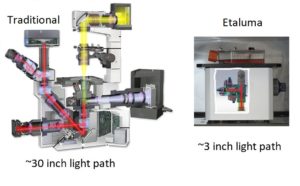Top 3 Customer Misconceptions About Digital Fluorescence Microscopes
1. CCDs are better than CMOS camera sensors.
Well, Sony doesn’t think so…
“Sony Corporation is going to stop its CCD image sensor business by the end of March 2017. It comes as a surprise for many industry experts who think the market for CCD image sensor in machine vision and security and surveillance camera is still having its impact. “ MORE
And CMOS has many on-chip advantages…
“Charge-Coupled Devices (CCDs) were originally the right answer…CMOS sensors, however, are the better choice in most cases. Much of this has been about chip process. CCDs are largely analog devices, and need special production processes that aren’t really used by other devices. This has slowed the evolution of CCDs and kept the prices high — CCDs today are absolutely more expensive than CMOS imagers of the same resolution.” MORE
2. LEDs need to be very bright for use in microscopy.
True if you need to excite within the inefficient optics of a traditional microscope. Not true if you design a microscope to have high photon efficiency. A short light path and minimal optical elements all contribute to reducing the need for bright excitation sources. Our LEDs are rated at around 1 watt at low voltage DC. They are rarely needed above 50% intensity.
3. Microscopes can’t operate in 37 C, 95% RH cell culture incubators.
 I have had customers outright challenge me on the veracity of our product environmental tolerances. One PI said, “We do not believe this is possible.” OK, but let me show you.
I have had customers outright challenge me on the veracity of our product environmental tolerances. One PI said, “We do not believe this is possible.” OK, but let me show you.
“What about condensation?” If you have ever come in from skiing with glasses on, you will immediately condense the warmer, wetter air of the après ski bar onto their surfaces. One generally removes their glasses and orders a beverage. By the time that beverage is finished, the condensation has disappeared and the glasses can be worn again. This is similar to what happens when we first put a room temperature LS Microscope into a warm incubator. Condensation forms on the external surfaces for a short time before the LS Microscope temperature equilibrates and the condensation evaporates for good. It’s relevant to point out that many electronic devices function fine in the tropics where temperature and humidity reach levels found in incubators. It also helps that we put only low voltage DC into the microscopes!
Check out our article on Live Cell Imaging.

